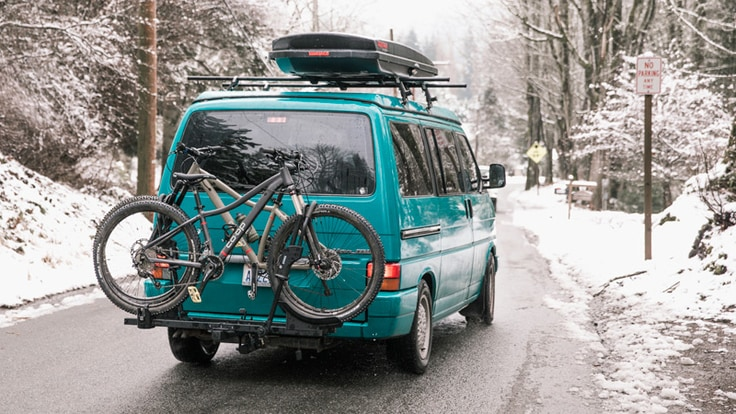
You’ve spent a lot of time and money to find the right gear for your outdoor excursions. You’ll want to ensure that equipment gets where it needs to go so you can spend less time worrying about gear and more time having fun. Car racks let you haul outdoor toys while freeing up room inside your vehicle. In this article, we’ll cover tips to narrow your choices when picking a car rack for your next big adventure.
Here are some things to know before choosing a car rack:
Below is a quick overview of your gear-hauling choices, followed by a more detailed look at car rack options based on the activity or activities you’re doing.
|
Rack Style |
Accommodates |
Pros |
Cons |
|
Hitch Bike Racks |
· Bikes · Can be adapted to carry skis, snowboards, and cargo holders |
· Simple installation · Easy to load and access bikes · Some models allow clear access to the rear door · Good for frequent use |
· Advanced models can be expensive · Basic models interfere with access to the trunk or rear cargo area · Bikes may sway |
|
Roof Racks |
· Bikes · Boats · Skis · Snowboards · Paddle boards · Surfboards · Cargo boxes |
· Most versatile system · More secure and stable · Unimpeded access to car doors, rear hatch or trunk |
· Some hoisting and reaching required · Wind resistance · May not fit in low-clearance spaces |
|
Cargo Boxes |
· Skis · Snowboards · Loose gear |
· Enclosed · Lockable gear storage · Can hold wet or dirty items outside of vehicle interior · Keeps gear out of sight |
· Cost · Wind resistance · May not fit under low-clearance spaces |
|
Trunk Bike Racks |
· Bikes |
· Less expensive · Portable · Easy to load and access bikes · Can be used on multiple vehicles · Good for occasional use |
· Interferes with access to trunk or hatch · Bikes may sway and contact one another |
|
Truck Bed Racks |
· Bikes · Boats · Cargo boxes |
· Easy to load and access bikes · Can handle heavier loads · Can be attached to toolboxes |
· Bikes dominate storage capacity within the truck bed |
|
Spare-Tire Racks |
· Bikes · Can be adapted to carry skis, snowboards |
· Easy to load and access bikes · Provide clear access to trunk/rear door |
· Dependent on tire size · Can carry 2 bikes max · Bikes may sway |
|
$ = Up to $120 $$ = $120-$200 $$$ = $200-$400 $$$$ = $400+ |
|||
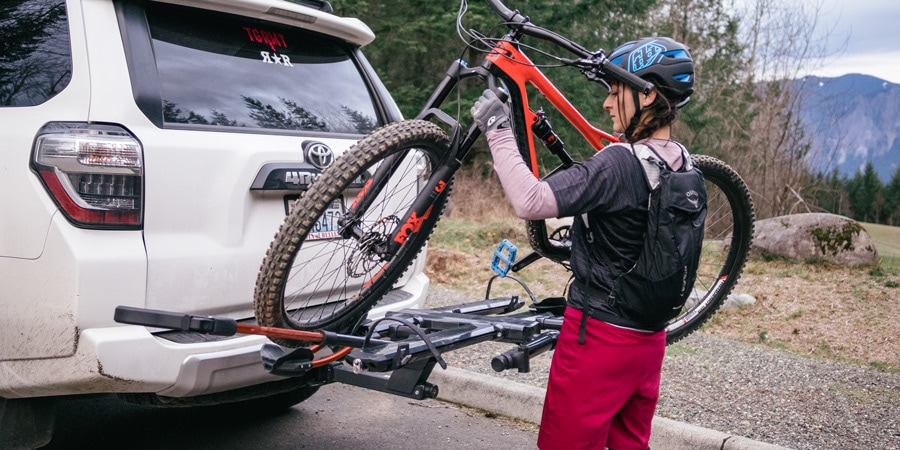
If biking is your sport, you’ve got several options for hauling one or more bikes.
Hitch bike racks: These racks mount on the trailer hitch at the rear and allow you to easily get to your bikes with moderate lifting (unlike roof racks). They’re simple to install and easy to use. They extend the length of your vehicle so backing up or maneuvering may be a concern for some. They also limit rear access but many models tilt down or swing away from the vehicle. Make sure the rack you choose is compatible with the size hitch receiver you have.
There are two types of hitch bike racks:
Roof bike racks: You may want to put your bike on the roof because it’s more secure, you need access to your rear trunk or you don’t want to install a trailer hitch. Roof racks are a good choice if you don’t mind lifting the bike onto the roof and low-clearance garages or ceilings aren’t an issue. Some roof rack styles let you secure bikes while keeping both wheels on while others require you to take the front wheel off and secure the fork.
Trunk bike racks are mounted to the trunk of your sedan or hatchback and secure bikes using a system of straps. They’re the most economical option for hauling bikes and don’t require a hitch or rack system. These racks can carry one to three bikes.
Truck bed bike racks: If you have a pickup truck, you have several truck bike rack options for hauling bikes. Using different mounts and other accessories, you can carry your bikes on a protective pad over the tailgate, upright in the truck bed or with bike forks secured onto a bar across the bed, in the bed or on the truck side rail. Some tailgate pads can handle up to seven bikes.
Spare tire bike racks: Fewer vehicles have spare tires in the rear these days, but if you do, spare tire bike racks are affordable options for hauling bikes. They typically carry about two bikes.
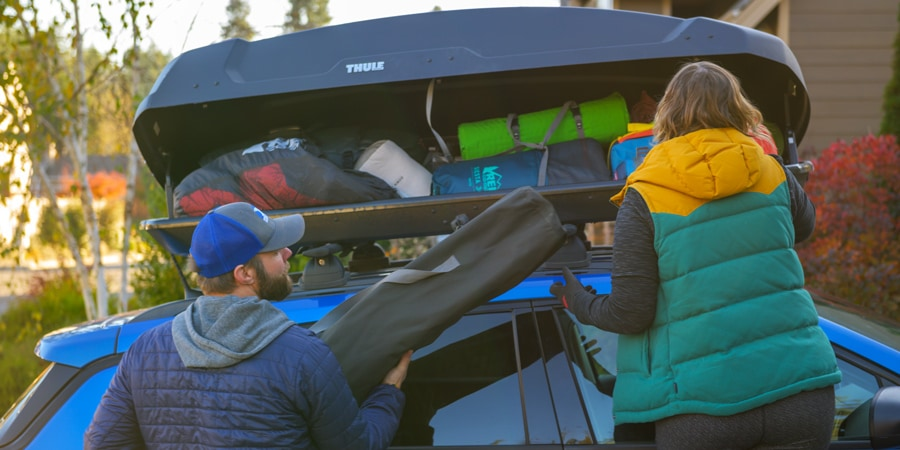
Cargo carriers provide secure, streamlined options for hauling a lot of camping gear and other cargo on top of the vehicle.
Rooftop cargo boxes: Hard-sided cargo boxes are more durable, can hold odd-shaped items, and can haul a lot of gear in all weather conditions. They’re a lot more expensive than cargo baskets or bags and take up storage space when not in the vehicle. Many open on both sides to make loading easier. In order to use most of them, you have to have a base roof rack with crossbars.
Rooftop cargo bags: If you’re limited in space, cargo bags hold a lot of regular-size gear such as luggage and fold up compact when not in use. They’re also less expensive than cargo baskets or boxes but may not be as durable. Most soft-sided carriers do not need a roof rack system.
Hitch mounted cargo carriers: These cargo trays or boxes go in the back of the vehicle. They’re great for loading large coolers or other gear that you need quick access to. However, hitch racks extend the length of your vehicle and you won’t be able to put bikes in the back.
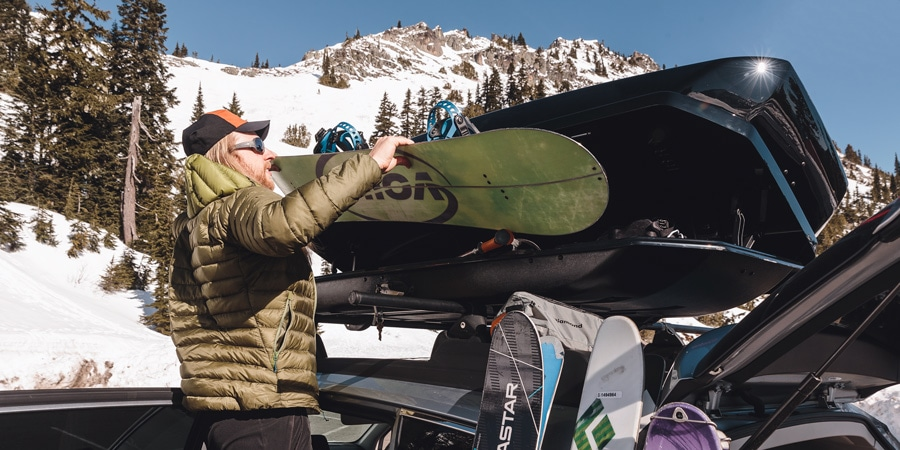
There are a number of ways you can carry your skis and snowboards.
Rooftop ski and snowboard racks: Ski and snowboard racks can fit a number of skis and boards, but they do require that you have a base roof rack (crossbars). They’re secure, simple to use, and less expensive than cargo boxes or hitches. Larger ones carry up to six pairs of skis or four boards.
Cargo boxes: Enclosed weather-proof cargo boxes are another option for hauling multiple skis and snowboards. Cargo boxes require a base roof rack to mount onto. They’re expensive compared to the other options for carrying skis and snowboards, but they’re also versatile if you plan to do other activities, like camping.
Hitch ski racks: Hanging-style bike hitch racks can be adapted to carry skis on your trailer hitch. Hitch ski and snowboard racks require a hitch bike rack, so that adds to the overall cost. Many can hold multiple skis and boards, which are easier to reach in the back of the vehicle rather than from the roof. Some carry four to six pairs of skis and two to four boards.
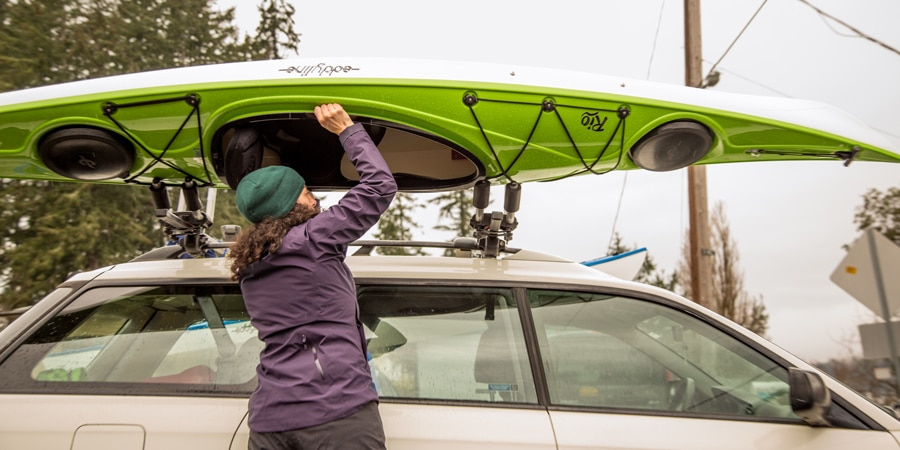
Roof racks: For many paddlers, roof racks are the most common choices to haul canoes, kayaks, surfboards, and stand up paddleboards. Many require a base roof rack (two crossbars) before you can mount specific racks to haul your kayak, paddle board , or canoe.
Once you have the base roof rack, you can decide how to haul your watercraft using these options:
For more information, read our article on Transporting a Kayak or Canoe or Transporting a SUP.
Truck racks: These mounts make it easy to carry boats that are too long to fit in the pickup truck bed. Utility racks, extenders or other posts let you carry boats above the truck bed.
Planning your next adventure is easier when you know it'll be easy to haul all your gear. With the proper roof rack on your vehicle, you can bring your bike, kayak, extra equipment, and even a rooftop tent with you.
Rack expert Andrew Pasquella helped us compile the ten things you should look for when buying a rack for your vehicle. Front Runner Outfitters is a vehicle-based adventure gear company with Africa-proven, elephant-strength camp gear. They build racks that can be used for weekend camping trips or month long overland excursions and understand that traveling with family can leave little room for everyone's gear.
Strong is good, heavy is not. Many racks are clunky and use heavy materials like steel, but you don’t have to sacrifice strength to lose weight. A well-engineered, all-aluminum rack will be 30 percent lighter than steel, with more strength and load carrying capacity.
A modular rack will allow for easy assembly, and let you add rack slats for different uses—like constructing a full platform, swapping out accidental damage, and adding items like expedition rails. The rack can change for whatever you need at any given time.
The best rack is one you’ll use for multiple purposes. Having the widest range of accessories creates endless adventure possibilities. Be sure your rack can accommodate mounts for water and fuel cans, roof top tents, bikes, skis, surfboards, axes, canoes/kayaks, and whatever else you may need.
Because companies will make it difficult to put competitor's accessories on their rack, be sure to make sure you're not locking yourself out of options you really want.
There is no quicker way to ruin a trip than with a rack failure. If you plan on heading into the backcountry, a cheap rack might not make it. Make sure the rack manufacturer specializes in building gear that has been proven in harsh conditions.
Don’t limit your adventure to asphalt just because you’re worried about rack strength. Some of the best camping spots are only accessible via fire roads and dirt trails!
No matter what you put on your roof, it will impact noise and fuel economy. The good news is that it’s possible to mitigate that impact with a low-profile rack. (“Basket-style” racks will do the opposite.)
A lower profile makes loading and unloading gear easier, gives easier access to low parking garages, and creates less drag which means less noise and better fuel mileage.
Fly-by-night rack companies are out there. They sell poorly made rip-offs, take your money, and disappear. Stick with companies that have been around for decades and can offer you live customer service to assist in rack installation or questions about performance.
Take a look at what some of your adventure heroes are using. Maybe it’s a hardened explorer like Kingsley Holgate, or a famous adventurer photographer like Alex Strohl, who needs the best equipment to get him to the hardest to reach places. Folks who need the toughest gear for their daily life have been through enough experimentation to know what works.
Look for a company that makes racks and accessories for a wide variety of vehicles. More racks and more accessories will mean more options for you no matter what you’re driving. The company will also have a better understanding of potential solutions for your needs. It's likely your rack will outlast your vehicle, so transferring it to your next set of wheels is always a good option.
More plastic components for both the rack and accessories means more chance for failure. Plastic becomes brittle, has an inferior load rating, fades in the sun and breaks are much more likely. Companies will use cheap materials because of their lower cost but this is truly a case of you get what you pay for. Not worth the risk.
